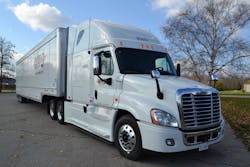Jeff Wood, director of safety for Martin Transportation System – a nearly 1,000-truck, 1,400-driver fleet providing dedicated long-haul, regional, and local transportation for the “Big 3” automakers – believes inward and outward facing cameras will be absolutely vital tools for commercial drivers going forward, well outweighing concerns over privacy.
“There are just too many situations out there today where [truck] drivers get blamed in minor and major traffic incidents where they are not at fault, yet the cop takes the other side,” Wood, a former driver himself, explained to Fleet Owner.
“I tell our drivers that cameras are a great silent witness because if nothing happens, nothing is recorded,” he stressed. “I also tell them that if they don’t like cameras, then they shouldn’t go to the mall, the grocery store, or the gas station, because most are now under 24/7 video surveillance. They see everything, down to the flavor of Slim Jim you just bought. It’s a new world out there in a lot of ways”
Martin recently installed the Lytx DriveCam program on its trucks and Wood noted that the system is already paying a variety of dividends, especially in terms of driver exoneration.
“We had an intersection collision case where may guy is trying to turn left. He had to ‘creep out’ into the intersection, because there wasn’t a [dedicated] left-hand turn signal,” he said.“As the light changes and he pulls through, a driver coming in the opposite direction pulls around a stopped car, goes through the red light, and hits our truck,” Wood noted. “When the police arrive, the driver of the car said he had a green light and that the truck turned into his path. But we just shared the video with the police … and no other witness was necessary. That saved us potentially hundreds of thousands of dollars in claims, with the added benefit of getting us money back for our equipment damage."
He added that, without video, such collisions result in a “word vs. word” situation – one that usually turns into a long-drawn out legal battle that can drag on for years and costs tens of thousands of dollars.
"Trucking companies are also targets of inflated and downright false claims," Wood said. "Every claim that's forced into settlement to avoid costly litigation is money straight off our bottom line.”
He emphasized, though, that video is a “two-edged sword” and will show if a truck driver is in the wrong – something Martin has experienced. But there is a silver lining for a motor carrier in such cases.
“If it is our fault, we can just settle the case outright,” Wood said. “With video, we know when we’re in the right and when we’re in the wrong. And that is really helping us.”
While he noted that it is “too soon” to affix dollar-figure savings to Martin’s use of driver cameras, Wood stressed that video such cameras provide vastly enhances his safety training efforts and allows the fleet’s operations managers to really see what their drivers face on the road every day.
“We capture video showing our drivers avoiding wrecks; showing them on their toes and anticipating problems,” he explained. “That allows us to show their managers what their drivers are dealing with and allows us to tell them ‘nice job’ for something that, back in my day behind the wheel, no one would ever have known about.”
The training value of driver video is vital, too, as Wood uses montages of crashes to show drivers the dangers posed by not wearing seat belts, following too closely, and being distracted by cell phone use.
“There is no greater way of getting their attention,” he said. “It shows just how fast bad things can happen; it shocks everybody and teaches us things.”
In terms of convincing Martin’s drivers to accept inward and outward facing camera technology, Wood noted that he followed a gradual step-by-step plan.
“First, we just ‘dropped the bomb’ so to speak; telling everyone we were planning to do this [install cameras] and let the initial shockwaves pass,” he explained. “Then we ran a pilot test with 50 cameras in different trucks, so our drivers would understand how they worked,” followed by a fleet-wide install starting in July last year.
Wood added that he preferred to discuss cameras with Martin’s drivers one-on-one over coffee, versus a big meeting in a conference room or in his office; giving them a chance in a more “casual” environment to air their concerns but also allowing him to share the fleet’s view.
“Even the best drivers can bring habits with them that might lead to risky situations,” he explained. “This program helps us identify – and improve – unsafe driving patterns that in many cases can go undetected until something bad happens.”
Real-time feedback about real situations is the key, Wood believes.
“Increasing following space, wearing seat belts, and making the cab free from distractions are all critical driving practices [and] DriveCam video gives us the opportunity to sit down with our drivers and show them how they can fine-tune their driving skills using real events, not hypotheticals," he said. "The program also sends a message to our drivers, our employees, and our customers that we're serious about safety."
About the Author
Sean Kilcarr
Editor in Chief
Sean Kilcarr is a former longtime FleetOwner senior editor who wrote for the publication from 2000 to 2018. He served as editor-in-chief from 2017 to 2018.

